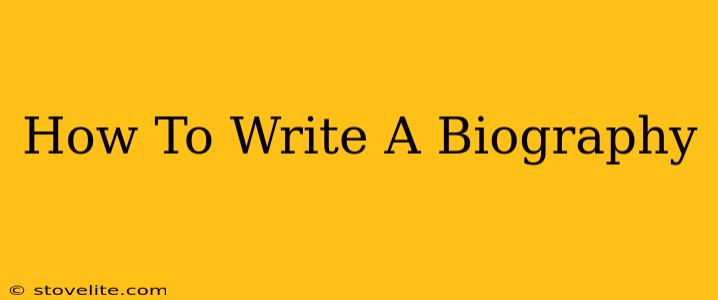Writing a biography, whether it's about a famous figure or someone you know personally, can be a rewarding experience. It's a chance to preserve a life story, share inspiring narratives, and offer a glimpse into the past. But crafting a compelling and informative biography requires planning and skill. This guide will walk you through the process, step-by-step, ensuring your biography is engaging and well-structured.
Understanding the Purpose of Your Biography
Before you begin writing, define the purpose of your biography. Are you aiming to:
- Celebrate achievements? Focus on highlighting significant accomplishments and milestones.
- Explore a complex personality? Delve into the subject's motivations, struggles, and contradictions.
- Document historical events? Weave the subject's life into the larger context of their time period.
- Inspire others? Highlight lessons learned, overcoming challenges, and positive impacts.
Understanding your purpose will guide your research and writing style.
Research: The Foundation of a Great Biography
Thorough research is the cornerstone of any successful biography. This involves:
Gathering Information:
- Interviews: Conduct interviews with the subject, family members, friends, colleagues, and anyone who knew them.
- Archival Research: Explore archives, libraries, and historical societies for documents, letters, photographs, and other primary sources.
- Public Records: Access birth certificates, marriage licenses, census records, and other official documents.
- Published Works: Review books, articles, and other publications related to the subject.
- Online Resources: Utilize online databases, websites, and social media to gather information.
Organizing Your Research:
As you collect information, organize it systematically. Use a system that works for you—whether it's a detailed outline, index cards, or a digital database. This will make the writing process significantly easier. Consider using different colored index cards or folders to categorize information by topic or time period.
Structuring Your Biography: A Chronological Approach
While different approaches exist, a chronological structure is often the most effective for biographies. This involves presenting the subject's life in a linear fashion, from birth to death. However, you can also employ thematic or topical structures depending on your subject and chosen focus.
Key Elements of a Chronological Structure:
- Early Life and Family Background: Begin with the subject's birth, childhood, family, and formative years.
- Education and Career: Detail their education, professional life, and significant accomplishments.
- Relationships and Personal Life: Explore their relationships, friendships, loves, and significant personal events.
- Challenges and Triumphs: Highlight obstacles faced and how they were overcome, focusing on resilience and growth.
- Legacy and Impact: Conclude by summarizing their lasting impact, contributions, and legacy.
Writing Style and Tone:
Your writing style should be engaging, clear, and accurate. Use vivid language to bring the subject's life to life. Consider the following:
- Show, Don't Tell: Use descriptive language and anecdotes to illustrate your points rather than simply stating facts.
- Maintain Objectivity: While you can express admiration or empathy, strive for objectivity in presenting the information.
- Use Quotes Effectively: Incorporate quotes from interviews, letters, and other sources to add authenticity and voice.
- Edit and Revise: Thoroughly edit and revise your work for clarity, grammar, and style.
SEO Optimization for Your Biography
To maximize visibility online, consider these SEO best practices:
- Keyword Research: Identify relevant keywords related to your subject and incorporate them naturally throughout the text.
- Meta Description: Craft a compelling meta description that accurately summarizes the biography and includes relevant keywords.
- Title Tag: Create a title tag that is both descriptive and keyword-rich.
- Image Optimization: Use relevant images with descriptive alt text to improve SEO and user experience.
- Internal and External Linking: Link to relevant internal pages and reputable external sources.
By following these steps, you can craft a compelling and informative biography that will capture the reader's attention and stand the test of time. Remember, patience and persistence are key! Good luck!

